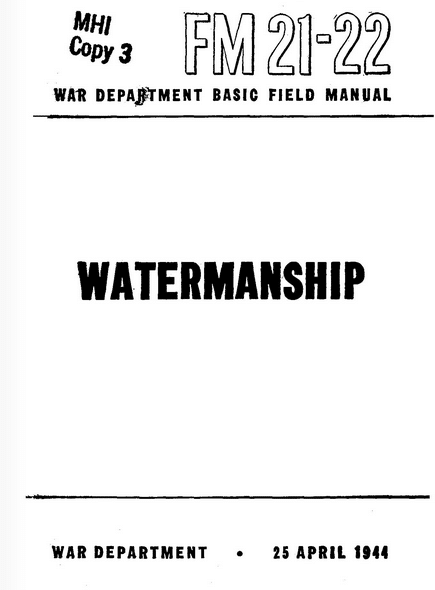
Editor’s note: In 1944, the US War Department published FM 21-22, a manual on military watermanship. The manual covers everything a man needs to know to survive at sea, from how to properly abandon a sinking ship to how to stay alive in a lifeboat. This week we’ll be highlighting several of the manual’s sections; the information is both fascinating from a historical standpoint and useful for worst case scenarios.
FM 21-22 War Department Watermanship Manual, 1944
LIFE NETS.
a. General. Life nets or cargo nets are normally hung over the side of a ship and are used as broad ladders for disembarking into landing craft or abandoning ship. Their width allows four to six men to climb down abreast, and all men should know how to use them quickly and safely.
b. Descending nets. Four to six men abreast start over the ship’s side simultaneously, left foot first. The left foot is always swung over first whether descending from our own or allied vessels. When the first line of soldiers has descended halfway, another line starts over the side. Thus there are always a line of soldiers starting over the side, a line halfway down, and a line at the lower end of the net.
c. Methods of descending.
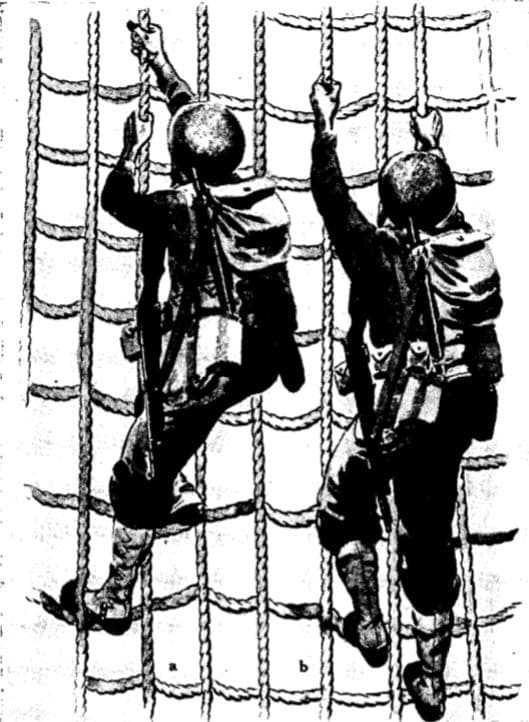
Descend life net (a) by grasping single vertical strand with feet on horizontal strands on either side of vertical strand; (b) by grasping outside strands of group of three vertical strands with feet on either side of center vertical strand.
There are two methods of climbing down life nets.
(1) Hands grasp a single vertical strand, the feet being on the horizontal strands on either side of the vertical strand (“a” above).
(2) Hands grasp the outside strands of a group of three vertical strands, the feet being on either side of the center strand (“b” above).
(3) In either method the man grasps vertical, not horizontal, strands of the net so that his hands will not be stepped on by a man descending above him. Hands are well above the head, head up, feet skipping one square at a time. Longer steps slow the descent. Look up, not down.
d. Dropping from net.
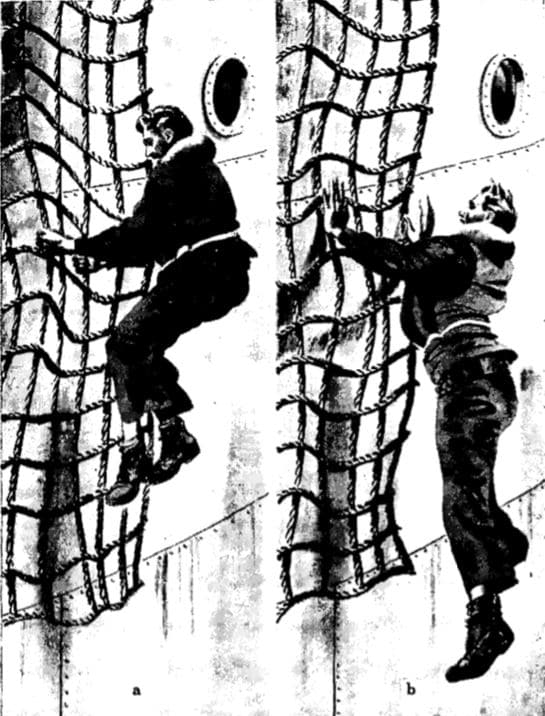
Jumping from life net. (a) Place feet on same horizontal strand nearest bottom of net; descend into a crouch using hands, arms are bent. (b) Shove off with hand and feet, and straighten body.
In vessels not combat-loaded the nets may not reach the water and it may be necessary to drop from the end of the net. To drop from the net, place both feet on the same horizontal strand near the bottom of the net. Now bring the hands down until the body is hanging in a crouched, position with arms bent. Kick with the legs and push with the hands, bringing the body vertical as you drop into the water.
e. Lowering survivors.
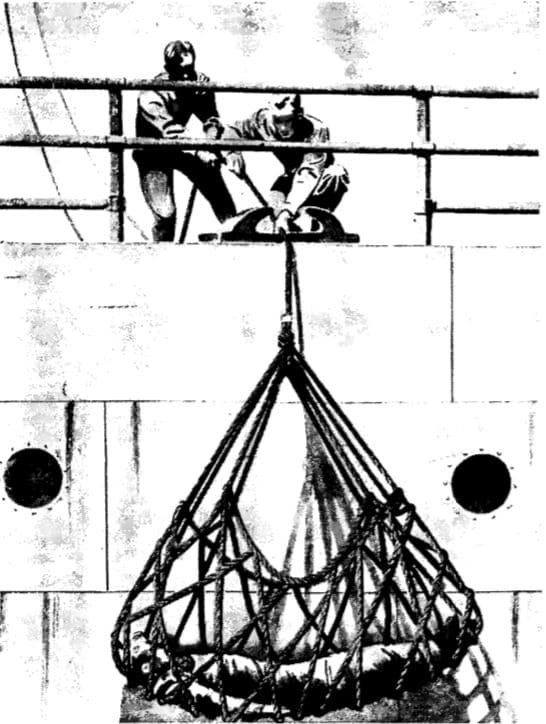
Lower disabled survivor using a cargo net. Lengthwise corners are gathered and secured to lowering line.
To lower a disabled survivor over the side, place him in the middle of an unattached cargo net, bring the lengthwise net corners together, and attach a lowering line to them. By this means the disabled survivor can be lowered any required distance to the lifeboat or raft with the least risk of further injury.
BOOM LADDERS.
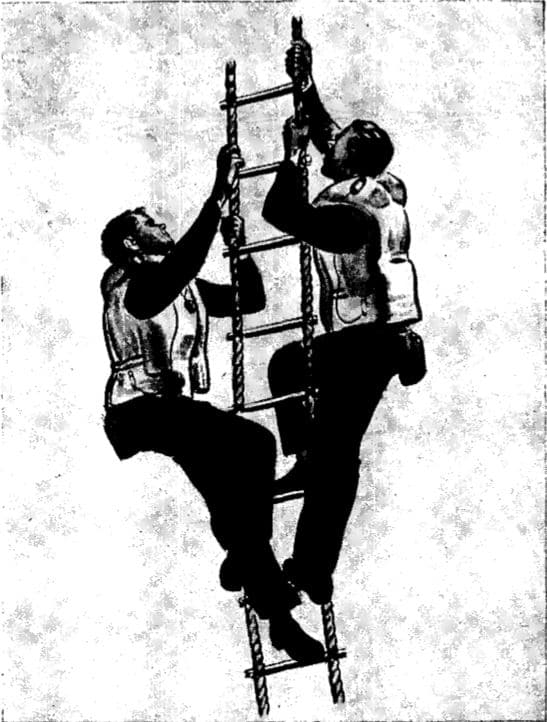
Descend boom ladder one rung at a time hand under hand using either rope, place leg on either side; keep rung ends pointed at body. Leg and arm on same side move together.
These are rope ladders with round wooden rungs, hung from a boom or other projection over a ship’s side. They may be descended hand under hand on either rope, placing a leg on either side with the rung end toward the body; descend one rung at a time, leg and arm on the same side working together. Thus, two men can use the ladder simultaneously.
JACOB’S LADDERS.
These are rope ladders with flat steps. Hands grasp the vertical ropes and feet skip one step at a time. Hand and leg on the same side move together.
SINGLE ROPES.
a. General use. Ropes of various sizes and lengths are usually on deck. They can be attached to parts of the ship and thrown over the side to descend to the water. It is always better to climb down the side than to jump off a ship.
b. Methods of descending ropes. Climb over the side and grasp the rope with the feet before grasping with the hands to go down hand under hand. Grasp the rope one hand over, not on, the other. Arms are slightly bent. There should be a sensation of holding and gripping, rather than hanging. Descend slowly, hand under hand.
c. Leg grips. The leg grip depends on the tautness or slackness of the rope, its size and weight, the length of descent, and the condition of the hands.

Descend taut rope hand under hand, with legs crossed, one knee drawn up, and toes pointed up. Rope runs along inside of leg with knee drawn up, over front of ankle and down outside edge of foot. Other foot is crossed over to clinch rope along outside edges of feet near heels. Apply pressure with knees and feet to slow descent.
(1) Taut rope. On a taut rope the legs are crossed with one knee drawn up and the toes lifted. The rope runs along the inside of this leg, over the front of the ankle, and down the outside edge of the foot. The other foot is crossed over so it clinches the rope between the outside edges of the feet near the heels. Applying pressure with knees and feet slows the descent.
(2) Loose rope. When the rope is sufficiently loose either of two leg grips may be used:
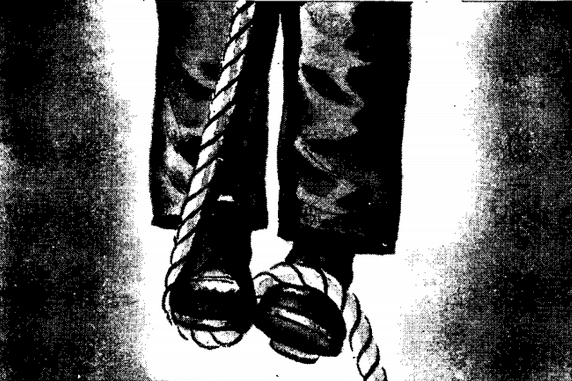
Rope lies along outside of one leg, under foot of that leg, and over foot of other leg. Pressure of feet regulates descent.
(a) Stirrup grip. Legs are straight and held together. The rope lies along the outside of one leg, under the foot and over the foot of the other leg. Pressure of one foot against the other regulates the speed of descent. Hand under hand method may be used or the hands may slide together, taking a firm hold when foot pressure stops the descent. If the hands are disabled the rope is hugged with the arms, possibly with a half turn around one arm and with the other arched against it to check the slip.
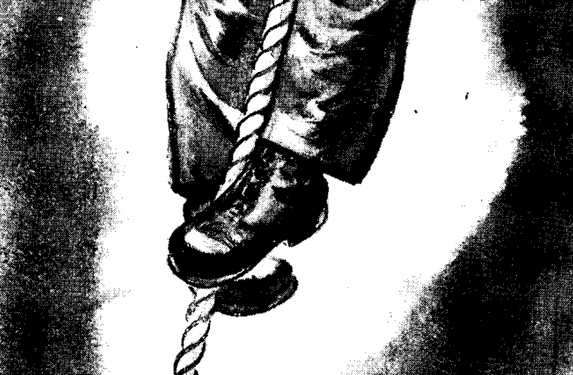
Rope lies between legs and across instep of foot. Pressure of other foot upon rope acts as brake.
(b) Secure foot grip. This grip is best for long descents where the arms may need to be rested. The rope drops between the legs and across the instep of one foot. The other foot steps on the rope where it crosses the instep and, by applying pressure, grasps or releases it.
d. Knotted ropes.
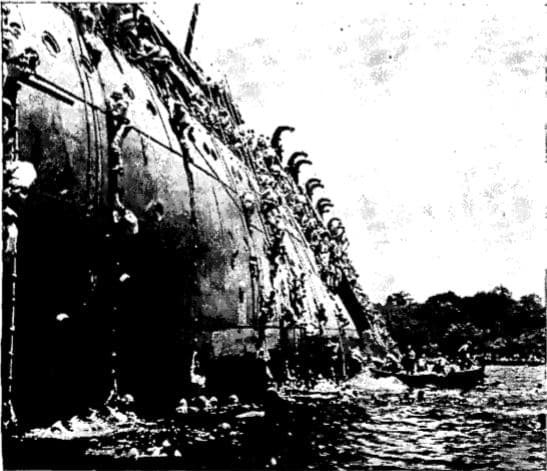
Photograph of use of knotted ropes in abandoning U.S.S. President Coolidge.
(1) Ropes used for abandoning ship usually have knots at frequent intervals. The feet and hands can easily grasp the rope just above the knots, allowing some muscular relaxation and preventing slips and rope burns. The feet are kept together, pressing the rope between the insteps. Legs and arms are slightly bent.
(2) Grasp the rope with the hands just above a knot. Release the feet and lower them on to the next knot. Hold with the feet and bring the hands down one knot.
e. Deliberate descents. Rope descents should be deliberate and unhurried, legs and feet applying pressure to prevent arm strain and the consequent slipping and hurrying. Long or fast drops or slipping will cause severe rope burns. Skillful use of the feet and legs is the surest safeguard.
f. Discipline. When a single rope is being used by several men either at the same time or in succession they should space themselves so that they do not crowd up, but keep well separated. Discipline must be maintained, and groups retained in control. Look out for other men coming down ropes. A man above may slip and fall heavily on the man below.
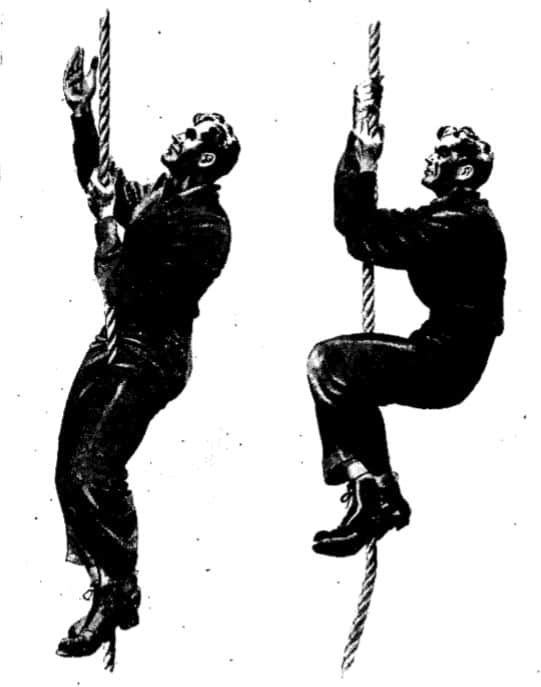
Climbing a rope. Grasp rope overhead to limit of reach; use taut leg grip. Pull legs up high and “brake” rope; relax hands and reach for new grip.
g. Climbing a rope. The rope is grasped with the hands as far up as possible and, holding with the hands, the legs are brought up as high as possible and grip the rope, using the taut leg grip. The hands are relaxed and reach for a new hold above; the legs are moved up for a new grip and the rope then is climbed by alternately pulling with the hands and holding fast with legs.
Read the Entire Series
Survival Swimming
Abandoning Ship
Surviving Aboard a Life Raft


